Abstract
Objectives. Comparison of survival after percutaneous coronary intervention (PCI) or coronary artery bypass grafting (CABG) in patients with coronary disease. Design. Feiring Heart Clinic treated 10 815 patients with a coronary intervention (6366 PCI, 4449 CABG) from March 1999 to December 31, 2005. Their survival status as of May 31, 2006 was ascertained through the Norwegian National Registry. Survival in PCI and CABG cohorts was compared using Cox regression and propensity analysis. Results. Covariate adjusted survival was significantly improved by CABG compared to PCI in patients with three vessel disease with and without diabetes, with hazard ratios of 0.40 and 0.61, respectively. The difference was of borderline significance in patients with one/two vessel disease with diabetes, and no difference in survival between the strategies in patients with one/two vessel disease without diabetes. Propensity analysis supported these observations. Improved survival for the PCI cohort was observed in the last quintile of procedure times. Conclusions. Patients with three vessel disease with or without diabetes seem to have a survival benefit with CABG compared to PCI treatment.
It is well established that coronary artery bypass grafting (CABG) improves survival compared to medical treatment in moderate and high risk subgroups Citation1, Citation2. The effect of percutaneous coronary intervention (PCI) on survival is more controversial Citation3–5. A number of studies have compared survival after PCI or CABG, observational studies from databases Citation2, Citation6–9, randomized studies Citation10–16 and a meta-analysis Citation17, but survival equivalence between the two treatments is still debated Citation2, Citation9, Citation14–18.
Feiring Heart Clinic has been conducting PCI and open heart surgery since 1989. From 1999 a common database has been used in surgical and cardiological department. The clinic is a high volume centre both on institutional level and operator level with an average of 1100 open heart surgical procedures and 1700 PCI procedures yearly in this period. The aim of this study was to compare the long-term survival of the patient in this database based on the initial choice of treatment – PCI or CABG.
Materials
Patients were identified from the institution's database containing data on demographics, clinical and angiographic parameters, treatment, diagnoses (ICD 10) and surgical operative codes (Nordic Medico-Statistical Committee Classification of Surgical Procedures, NCSP). Their survival status as of May 31, 2006 was established through the Norwegian National Registry. The endpoint was death from any cause. Patients that had emigrated were censored at their emigration date. Through the database 18 070 individual patients who had been admitted to the cardiological department between March 1999 and December 31, 2005 were identified. A total of 293 patients could not be identified in the national registry and were dropped from the analyses. For 97 patients some crucial information was lacking in the database making them unsuitable for analyses.
That left 17 680 patients examined with coronary angiography in the period with known survival status. In 2591 patients no coronary artery disease was detected, while in 3094 patients revascularization was judged unnecessary or impossible. Among the surgical patients 1180 had an additional procedure (valve replacement, valvuloplasty etc.) to bypass surgery and were excluded from the analyses. Thus 10 815 patients (6366 patients with PCI and 4449 with CABG surgery) were included in the analyses.
Statistical analyses
The purpose of the analyses was to determine whether long-term mortality differed between the initial treatment strategy choice (PCI or CABG) after controlling for differences in baseline risk factors. The data was analyzed both with a “per protocol” approach where bypass surgery was considered the initial treatment strategy if performed during the initial admission, regardless of antecedent PCI during the same admission and an “intention to treat” approach were PCI was considered the initial strategy if performed before bypass surgery during the initial admission. New revascularization was analyzed by the “intention to treat” approach.
Continuous covariates all differed from normal distribution as assessed by the skewness and kurtosis test and were therefore evaluated by the Kruskal-Wallis test for differences between the strategies. Categorical covariates were assessed by Fisher's exact test or χ2 test as appropriate. Univariate analyses of survival were performed using Kaplan-Meier product limit estimator and log-rank tests. Covariates that either affected univariate survival or differed between the two treatment strategies were entered into a multivariate Cox proportional hazard model. The Cox model was built by a forward selection procedure. In the multivariate analyses missing values for covariates were substituted by imputation using a best subset multiple regression based on the other covariates, and the model was tested with and without imputation to rule out significant effect of the imputation itself. Continuous covariates were evaluated for linearity in log hazard by quartile plots and the by the method of fractional polynomials. Ordinal variables were entered as dummy variables and each coefficient was evaluated for significance and linearity in log hazard. The proportional hazards assumption in the Cox model was checked by tests based on Schoenfeld residuals, and by including interaction term with time.
Interaction terms between covariates were kept in the model if they were statistical significant and biologically interesting.
The problem of selection bias was evaluated by a propensity analysis Citation19, Citation20. Covariates that significantly affected the choice of initial strategy were fitted in a multiple logistic regression model including significant interaction terms. The continuous covariates in the logistic regression model were checked for linearity, and the model itself checked with Hosmer and Lemeshow goodness-of-fit test. From the final logistic model the c-statistics (area under receiver operating characteristic curve) and propensity scores were calculated. In clinically interesting subgroups the propensity scores were divided in quintiles and hazard ratios compared across quintiles. All analyses were conducted with the use of STATA software version 9 (College Station, Texas, USA).
Results
During the whole study period 81% of the PCI's were performed en suite, increasing to 93% the last three years. The median delay for the surgical intervention was 6 days (interquartile range 2–18 days) after the angiography. The median follow-up in 6366 patients in the PCI cohort was 3.3 years (interquartile range, 1.8–4.8) and 3.8 years in 4449 patients in the CABG cohort (interquartile range, 2.2–5.3). The total number of deaths was 450 (7.1%) in the PCI group and 350 (7.9%) in the CABG group. The short-term mortality was low in both cohorts with 0.5% for PCI treated and 0.8% in the surgical group (p = 0.06) after 30 days. Stents were deployed in 74% of the treated lesions during this period. The average Euroscore in the surgical cohort was (mean±SD) 4.8±3.1 and the internal mammary artery was used in 96.7% of the operations. The unadjusted Kaplan-Meier estimate of survival in the two groups is given in , yielding a survival close to 90% after 5 years and revealing no difference between the cohorts. However, patients allocated to the two treatment strategies differed significantly in a number of baseline parameters () of which many have known significant impact on survival.
Figure 1. Kaplan-Meier estimate of unadjusted survival in the two strategy groups. The difference is not statistical significant (p = 0.93 – logrank test).
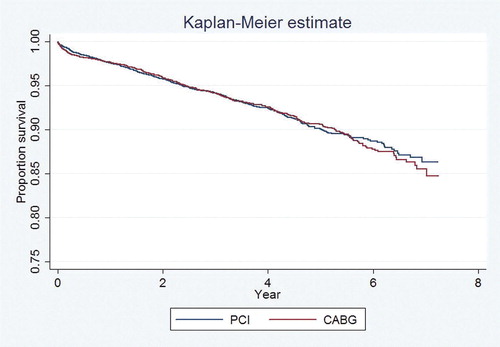
Table I. Baseline characteristics.
The variables in were tested in the multivariate Cox model. By a forward selection procedure age, ejection fraction, gender, smoking, diabetes, Canadian Cardiovascular Society (CCS) functional class, ischemia at exercise ECG, initial treatment strategy, number of diseased vessels, unstable angina, other significant disease and generalized arteriosclerosis were found significant. CCS functional class was included as a dichotomous variable divided between class one and two. Number of diseased vessel was included as a dichotomous variable divided between one and two vessel disease versus three vessel disease. The variables were all highly significant in the model (p < 0.01). A total of eight statistical significant interactions were found. The interactions between strategy and diabetes and strategy and number of diseased vessels were kept in the model as they were both statistical significant and biologically interesting for the study. The other interactions were dropped because they had no interest for this analysis and had minimal effect on the other coefficients. Gender had no significant interaction term. The final model contained 12 main effects and two interaction terms and was tested both by the “per protocol” and “intention to treat” approach, yielding near identical results. For simplicity only the results from the “per protocol” approach are presented.
Hazard ratios for death were computed from this model in clinically interesting subgroups with corresponding survival curves for three of the comparisons in . For one and two vessel disease without diabetes the curves for the two strategies are virtually identical.
Figure 2. Survival curves from final Cox model in diabetics with one and two vessel disease. Hazard ratio for CABG versus PCI is 0.66 (99.5% CI 0.36–1.23). The difference is statistically of borderline significance (p = 0.064).
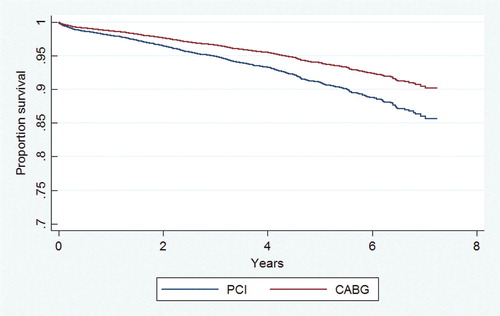
Figure 3. Survival curves from final Cox model in non diabetics with three vessel disease. Hazard ratio for CABG versus PCI is 0.61 (99.5% CI 0.46–0.80). The difference is statistically different (p < 0.001, Bonferroni adjusted).
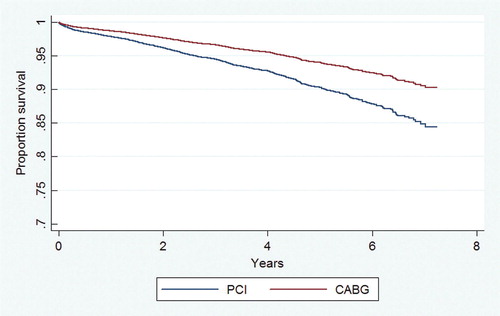
Figure 4. Survival curves from final Cox model in diabetics with three vessel disease. Hazard ratio for CABG versus PCI is 0.40 (99.5% CI 0.24–0.67). The difference is statistically different (p < 0.001, Bonferroni adjusted).
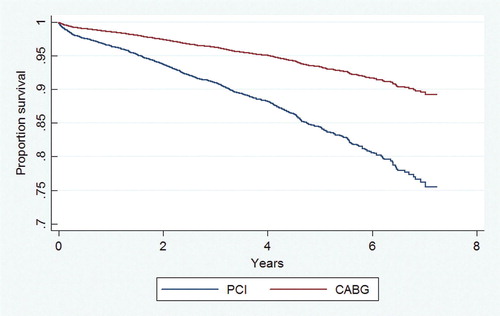
This population contained only 277 patients with ST elevation infarcts. The exclusion of these patients from the analyses had no impact on the results.
To evaluate any time trend in survival due to improvement in either treatment, procedure dates were divided into quintiles and added to the model as dummy variables. In the CABG group no hazard ratio for the quintiles were different from one, while the last quintile in the PCI group had a significantly lower hazard ratio (0.61 95% CI 0.40–0.94) compared to the four others, supporting an assumption of improvement in PCI results in the last years. The subgroup contained, however, only 2087 patients with a total of 55 deaths and therefore the confidence intervals for the hazard ratios were quite wide. In this subgroup CABG actually had a higher hazard ratio compared to PCI in three vessel disease without diabetes (1.08, 95% CI 0.53–2.18), but in diabetics with three vessel disease the hazard ratio still favoured CABG (0.51 95% CI 0.15–1.74). Drug-eluting stents were used in 11.2% of the cases in the last quintile. There were no deaths among the patients treated with drug-eluting stents, but excluding them from the analyses had no significant impact on the hazard ratios.
The frequency of reintervention was much higher in the PCI group than in the CABG group with highly significant logrank test (). These figures are hampered by the uncertainty that revascularization at other institutions are not included in the data.
Figure 5. Estimated frequency of first reintervention between initial strategy and type of new intervention. The logrank test for initial strategy and any subsequent reintervention was highly significant (p < 0.001).
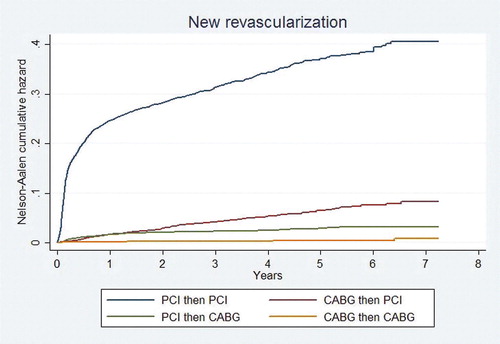
In the propensity analyses all covariates from were tested for significance in predicting treatment strategy in a logistic regression with PCI = 0 and CABG = 1. Significant interaction terms were included. The final model contained 13 main effects and 17 interaction terms and had a c-statistics of 0.84 indicating good discrimination. The Hosmer and Lemeshow goodness-of-fit test (χ2=13.86 8 df, p = 0.09) indicated a reasonable fit of the model to the data. The median propensity score in the PCI group was 0.17 (interquartile range 0.12–0.26), and 0.76 (0.34–0.84) in the CABG group. The all over hazard ratio for CABG versus PCI was 0.67 (95% CI 0.56–0.80) after adjusting for the propensity score used as a covariate in a Cox model. Clinical subgroups were divided in quintiles according to the propensity scores and hazard ratios computed across the quintiles. The propensity score in one and two vessel disease varied from 0.02 to 0.67, and the hazard ratios showed no pattern across the quintiles and varied from 0.28 to 1.83. In three vessel disease the score varied from 0.01 to 0.97 and hazard ratio consistently favoured CABG significantly across all quintiles varying from 0.50 to 0.66. Diabetics with three vessel disease had a variation in propensity score from 0.03 to 0.97, and the hazard ratios were in favour of CABG in all quintiles varying from 0.13 to 0.36 with four of five highly significant different.
Discussion
From the database 98.4% of the patients were identified in the Norwegian National Registry and their survival status as of May 31, 2006 ascertained.
Whether observational data should be presented using a per protocol or intention to treat approach is debatable and arguments for each strategy can be advocated. However, from a clinical point of view the per protocol approach seems the most reasonable, since a strategy of PCI might be chosen conditional on success of treatment of some specific lesion (for instance a chronic total occlusion). If the lesion cannot be treated successfully the patient is referred to CABG, and this can be seen as part of the initial strategy. However, in this study both approaches were analyzed and the results were nearly identical, making the distinction trivial.
The reinterventions were more frequent in the PCI cohort, consistent with all other reports from both observational and randomized studies. The absolute numbers are higher due to the fact that only reinterventions at our institution were available for analysis. It is reasonable to assume that the number of reinterventions at other institutions in this cohort would be relatively small since it would basically include only emergency procedures and it is very unlikely that the relative frequencies would be significantly altered by including reintervention at other institutions.
The short-term mortality (30 days) was low in both cohorts and the five years unadjusted survival in subgroups ranged from 93.5% in non-diabetics with one and two vessel disease treated with CABG to 72.8% in diabetics with three vessel disease treated with PCI. These survival rates seem to indicate a quality of treatments at least at the same level as has been reported from US databases Citation6, Citation8, Citation9.
The unadjusted survival for the treatment strategies was not different, but the CABG cohort was older and generally sicker. Adjusting for risk factors in the Cox model revealed significant differences in survival. The hazard ratios for patients with three vessel disease with and without diabetes were highly significant in favour of CABG, while it was of borderline significance in patients with one and two vessel disease with diabetes.
While randomized studies suffer from the lack of generalizability due to patient selection Citation8, Citation17, observational studies are susceptible to selection bias. The latter problem was addressed in the propensity analysis, which consistently yielded hazard ratios in favour of CABG in patients with three vessel disease across all quintiles.
In recent years a number of observational studies Citation2, Citation6–9 seem to corroborate the fact that patients with more severe coronary artery disease and especially three vessel disease, have an improved survival if treated surgically. Dzavik et al. Citation6 report a hazard ratio of 0.81 in favour of CABG in patients with multivessel disease. Brener et al. in Cleveland Citation7 found hazard ratios favouring CABG either adjusted by covariates or by propensity score. Malenka et al. Citation8 found a hazard ratio for survival of 0.60 in favour of CABG in three vessel disease. Hannan et al. Citation9 reported hazard ratios in favour of CABG in three vessel disease of 0.64 with proximal left anterior descending artery (LAD) involvement and 0.76 with non proximal LAD involvement. Recently Smith et al. Citation2 reported from the Duke database that in three vessel disease CABG improved survival significantly compared to PCI. These results are also supported by the meta-analysis of Hoffman et al. Citation17.
Apparently the results from the most recent randomized trials are somewhat in conflict with these studies. The Argentine randomized study of PCI with stenting versus CABG (ERACI II) Citation15 reports higher mortality in the CABG arm at 5 years follow-up. In this study however the 30 days mortality in the CABG cohort was especially high (5.7%) making valid comparison difficult. The most recent randomized trial The Arterial Revascularization Therapies Study (ARTS) Citation16 followed patients with multivessel disease for 5 years and reported the relative risk for death of 1.05 (95% CI: 0.71–1.55) for PCI compared to CABG. This is apparently at discrepancy with the present results. However, applying the coefficients from the Cox regression in this study and weighing them according to the frequency of two and three vessel disease in the ARTS study to calculate an average relative risk, the result would be 1.21. This figure is well within the 95% confidence interval for the all over relative risk in the ARTS study. Thus, the results are not necessarily conflicting.
A substantial reduction in hazard for death of 0.40 was found in diabetics with three vessel disease treated with CABG. The propensity analysis revealed a consistent survival benefit in diabetics with three vessel disease with hazard ratios from 0.19 to 0.36, in agreement with previous reports Citation7, Citation9. The hazard ratio in patients with one/two vessel disease with diabetes also clearly was in favour of CABG (0.66), but was of borderline statistical significance.
The 7 years follow-up of the Bypass Angioplasty Revascularization Investigation (BARI) randomized study Citation11 observed a substantial increased mortality in the diabetic cohort treated with PCI. Apparently the BARI Registry Citation21, Citation22 did not observe the same increased risk, but after adjusting for risk factors the diabetics in the registry also had an increased risk ratio of 1.41. The Emory Angioplasty versus Surgery Trial (EAST) study Citation12 at 8 years follow-up reported increased mortality in PCI cohort with diabetes. Hoffman et al. Citation17 in their meta-analysis found improved survival in the diabetics treated with CABG at 4 year follow-up, but the effect was no longer significant at 6 years. In the study of Brener et al. Citation7 the hazard ratios in the PCI cohort compared to CABG are increased significantly for both for insulin treated and non-insulin treated diabetics. Malenka et al. Citation8 obtained a hazard ratio of 1.52 (1.10–2.08) for PCI treated diabetics with three vessel disease. Hannan et al Citation9 found hazard ratios between 0.59 and 0.71 in favour of CABG in subgroups of diabetic patients. In the ARTS study the hazard ratio at 5 years follow-up for PCI treated diabetics was 1.61 (0.71–3.6).
One problem both observational and randomized studies have in common, is the time lag from procedure time to the time of publication. In this study patients were treated from 1999 to 2005 making this less of a problem, but even in such a short time span there are indications of improvement in survival in PCI treatment over time. In the last quintile of procedure dates there is no longer an indication of improved survival in the CABG cohort compared to PCI in patients with three vessel disease without diabetes. The reason for this improvement in PCI results is not obvious. Drug-eluting stents were infrequently used and is not a likely explanation. Prolonged use of clopidogrel with preprocedural initiation might be a factor. However the results are based on a relatively small subgroup and caution is warranted, but it might indicate that within a short period of time the results could be challenged and underlines the need for future studies.
When a treatment strategy is chosen the evidence of long-term procedure consequences is taken into consideration, in addition to individual aspects of the disease and patient preferences. Thus, procedure survival prospects would be just one aspect in choosing the treatment option. There are now numerous reports indicating that CABG has a survival benefit compared to PCI in three vessel disease, and in case of diabetes and three vessel disease the proof seems compelling. Thus the evidence of this difference in longevity should be an important factor in patient information and in decision-making for treatment of three vessel coronary heart disease.
Acknowledgements
I am in debt to Drs. Rasmus Moer, Sven Martin Almedal and Per Halvorsen for continuing quality control of the database and export of data. There is no conflict of interest.
References
- Yusuf S, Zucker D, Peduzz P, Fisher LD, Takaro T, Kennendy JW, et al. Effect of coronary artery bypass graft surgery on survival: Overview of 10-year results from randomised trial by the Coronary Artery Bypass graft Surgery Trialists Collaboration. Lancet. 1994; 344: 563–70
- Smith PK, Califf RM, Tuttle RH, Shaw LK, Lee KL, Delong ER, et al. Selection of surgical or percutaneous coronary intervention provides differential longevity benefit. Ann Thorac Surg. 2006; 82: 1420–9
- Bucher HC, Hengstler P, Schindler C, Guyatt GH. Percutaneous transluminal coronary agioplasty versus medical treatment for non-acute coronary heart disease: Meta-analysis of randomised controlled trials. BMJ. 2000; 3213: 73–7
- Henderson RA, Pocock SJ, Clayton TC, Knight R, Fox KAA, Julian DG, et al. for the Second Randomized Intervention treatment of Angina (RITA-2) Trial Participants. J Am Coll Cardiol. 2003; 42: 1161–70
- Katritsis DG, Ioannidis JP. Percutaneous coronary intervention versus conservative therapy in nonacute coronary artery disease: A meta-analysis. Circulation. 2005; 111: 2906–12
- Dzavik V, Ghali WA, Norris C, Mitchell LB, Koshal A, Saunders LD, et al. for the APPROACH Investigators. Long-term survival in 11,661 patients with multivessel coronary artery disease in the era of stenting: A report from the Alberta Provincial Project for Outcome Assessment in Coronary Heart Disease (APPROACH) Investigators. Am Heart J. 2001; 142: 119–26
- Brener SJ, Lytle BW, Casserly IP, Topol EJ, Lauer MS. Propensity analysis of long-term survival after surgical or percutaneous revascularization in patients with multivessel coronary disease and high-risk features. Circulation. 2004; 109: 2290–5
- Malenka DJ, Leavitt BJ, Hearne MJ, Robb JF, Baribeau YR, Ryan TJ, . for the Northern New England Cardiovascular Disease Study Group, et al. Comparing long-term survival of patients with multivesse coronary disease after CABG or PCI: Analysis of BARI-like patients in Northern New England. Circulation. 2005;112;371–6.
- Hannan EL, Racz MJ, Walford G, Jones RH, Ryan TJ, Bennett E, et al. Long-term outcomes of coronary-artery bypass grafting versus stentimplantation. New Engl J Med. 2005; 352: 2174–83
- The Bypass Angioplasty Revasularization Investigation (BARI) Investigators. Comparison of coronary bypass surgery with angioplasty in patients with multivessel disease. N Engl J Med. 1996;335:217–25.
- The BARI Investigators. Seven-year outcome in the bypass angioplasty revascularization investigation (BARI) by treatment and diabetic status. J Am Coll Cardiol. 2000;35:1122–9.
- King SB, 3rd, Kosinski AS, Guyton RA, Lembo NJ, Weintraub WS, for the Emory Angioplasty versus Surgery Trial (EAST) Investigators. Eight-year mortality in the Emory Angioplasty versus surgery trial (EAST). J Am Coll Cardiol. 2000;35:1116–21.
- Serruys PW, Unger F, Sousa JE, Jatene A, Bonnier IJRM, Schønberger JPAM, et al. for the Arterial revascularization Therapies study group. Comparison of coronary-artery bypass surgery and stenting for the treatment of multivessel disease. N Engl J Med. 2001; 344: 1117–24
- Stables RH. Coronary artery bypass surgery versus percutaneous coronary intervention with stent implantation in patients with mutivessel coronary artery disease (the Stent or Surgery trial): A randomized controlled trial. Lancet. 2002; 360: 965–70
- Rodriguez AE, Baldi J, Pereira CF, Navia J, Alemparte MR, Delacasa A, et al. on behalf of the ERACI II investigators. Five-year follow-up of the Argentine randomized trial of coronary angioplasty with stenting versus coronary bypass surgery in patients with multiple vessel disease (ERACI II). J Am Coll Cardiol. 2005; 46: 582–8
- Serruys PW, Ong ATL, van Herwerden LA, Sousa JE, Jatene A, Bonnier JJRM, et al. Five-year outcome after coronary stenting versus bypass surgery for the treatment of multivessel disease. J Am Coll Cardiol. 2005; 46: 575–81
- Hoffman SN, TenBrook JA, Jr, Wolf MP, Stephen G, Pauker SG, Salem DN, et al. A meta-analysis of randomized controlled trials comparing coronary artery bypass graft with percutaneous transluminal coronary angioplasty: One- to eight-year outcomes. J Am Coll Cardiol. 2003; 41: 1293–304
- Guyton RA. Coronary artery bypass is superior to drug-eluting stents in multivessel coronary artery disease. Ann Thorac Surg. 2006; 81: 1949–57
- Rosenbaum PR, Rubin DB. Reducing bias in observational studies using subclassification on the propensity score. J Am Stat Assoc. 1984; 79: 516–24
- Rosenbaum PR, Rubin DB. The central role of propensity score in observational studies for causal effects. Biometrika. 1983; 70: 41–55
- Feit F, Brooks MM, Sopko G, Keller NM, Rosen A, Krone R, et al. Long-term clinical outcome in the Bypass Angioplasty Revascularization Investigation Registry: Comparison with the randomized trial; BARI Investigators. Circulation. 2000; 101: 2795–802
- Detre KM, Guo P, Holubkov R, Califf RM, Sopko G, Bach R, et al. Coronary revascularization in diabetic patients: A comparison of the randomized and observational components of the Bypass Angioplasty Revascularization Investigation (BARI). Circulation. 1999; 99: 633–40
